This is “Public Relations and Sales Promotions”, chapter 12 from the book Marketing Principles (v. 1.0). For details on it (including licensing), click here.
For more information on the source of this book, or why it is available for free, please see the project's home page. You can browse or download additional books there. To download a .zip file containing this book to use offline, simply click here.
Chapter 12 Public Relations and Sales Promotions
You just finished reading a great newspaper story about a local restaurant even though you know the company has experienced several lawsuits and many customer complaints. The news story makes the restaurant sound like a great corporate citizen and the best place to eat in town. Sometimes a company gets “free” publicityPublicized information such as news stories about products and services, people, and organizations. such as news stories or reviews about its products and services in the mass media, even though the organization has no control over the content of the stories and might not even know about their publication. How did a restaurant with so many complaints manage to get such a great story written about it? How did it get good coverage when it might not be deserved? Perhaps the restaurant used part of its promotion budget to pay for public relations efforts to generate positive stories and positive publicity.
Public relations (PR)The process of creating a positive image for a company, an offering, or a person via publicity. includes information that an organization wants its public (customers, employees, stakeholders, general public) to know. PR involves creating a positive image for a company, an offering, or a person via publicity. PR has become more important in recent years because there are now so many media outlets people pay attention to, including YouTube, social networking sites, and blogs. It’s pretty easy for anyone to say anything about a company in public forum. Indeed, publicity is a double-edged sword; it can result in negative news, such as a poor review of a movie, restaurant, or car, or positive news. Organizations work hard to get favorable news stories, so while publicity sounds free, building relationships with journalists does cost money. Just like advertising (see Chapter 11 "Advertising, Integrated Marketing Communications, and the Changing Media Landscape" for discussion), public relations and sales promotions are critical components of the promotion budget for many firms.
Organizations also use sales promotions to generate positive customer perceptions and sales. Sales promotionsOther forms of promotions (coupons, contests, rebates, mail-in offers) not included as a component of a communication mix. are promotional activities companies do in addition to advertising, public relations, and personal selling in order to sell a product. Issuing coupons, running contests and games, and offering rebates and mail-in offers are examples of sales promotions. In this chapter, we examine the public relations and sales promotion tools that organizations use and how they contribute to a company’s success.
12.1 Public Relations Activities and Tools
Learning Objectives
- Understand the concept of public relations and why organizations allocate part of their promotional budgets to it.
- Understand what the different types of public relations tools are.
- Explain how companies use different public relations tools to their advantage.
Good public relations efforts can help a firm create rapport with its customers, promote what it has to offer, and supplement its sales efforts. Many organizations that engage in public relations have in-house PR departments, media relations groups, or investor relations groups. Other organizations sometimes hire external PR firms or advertising agencies to find and create public relations opportunities for them. PR specialists must build relationships with people at different media outlets to help get their stories placed. Universities, hospitals, government organizations, and charitable organizations often hire PR people to help disseminate positive information about their services and to increase interest in what they do.
PR specialists also help political campaign managers generate positive information in the press. PR specialists can handle damage control and put a positive view on situations when something bad happens to an organization or person. In foreign markets, PR agencies may help ensure product concepts are understood correctly. Getting all PR stories placed in desired media is not guaranteed. A lot of time and effort is spent getting to know people who can help publish or announce the information to the public.
Companies use a variety of tools for their public relations purposes, including annual reports, brochures and magazines for both employees and the public, Web sites to show good things they’re doing, speeches, blogs, and podcasts. Some of the most commonly used PR tools include press releases, sponsorships, product placements, and social media. Social media is discussed in Chapter 14 "Customer Satisfaction, Loyalty, and Empowerment".
Press Releases
Part of a company’s public relations efforts includes putting a positive spin on news stories. As we explained in Chapter 11 "Advertising, Integrated Marketing Communications, and the Changing Media Landscape", a press releaseA news story written by an organization to promote a product, service, or person. is a news story written by an organization to promote a product, organization, or person. Consider how much better a story or a product recommendation is likely to be perceived when the receiver thinks the content is from an objective third party rather than an organization writing about itself. Public relations personnel frequently prepare press releases in hopes that the news media will pick them up and disseminate the information to the public. However, there is no guarantee that the media will use a press release. Some of the PR opportunities that companies may seek to highlight in their press releases include charity events, awards, new products, company reports, and things they are doing to improve the environment or local community.
Read the following two examples of press releases. The first story sounds like it was written by a news organization, but it was created by Apple and their public relations people to highlight the introduction of the new iPhone 3G. The second press release and picture (see Figure 12.1 "A Picture of Stubb’s Legendary Kitchen’s “Feed the World Tour”") provide an example of how a company like Stubb’s Bar-B-Q teams up with Mobile Loaves & Fishes, a charity that helps feed the hungry, to help feed homeless and poor people and restock food banks around the country. The story enhances the positive image of both organizations.
An Example of a Press Release to Introduce a New Product
Apple Introduces the New iPhone 3G
Twice as Fast at Half the Price
SAN FRANCISCO—June 9, 2008—Apple® today introduced the new iPhone™ 3G, combining all the revolutionary features of iPhone with 3G networking that is twice as fast* as the first generation iPhone, built-in GPS for expanded location-based mobile services, and iPhone 2.0 software which includes support for Microsoft Exchange ActiveSync and runs the hundreds of third party applications already built with the recently released iPhone SDK. In the US the new iPhone 3G is priced at a stunning $199 for the 8GB model, and just $299 for the 16GB model.** iPhone 3G will be available in more than 70 countries later this year, beginning with customer availability in 22 countries—Australia, Austria, Belgium, Canada, Denmark, Finland, France, Germany, Hong Kong, Ireland, Italy, Japan, Mexico, Netherlands, New Zealand, Norway, Portugal, Spain, Sweden, Switzerland, UK and the US—on July 11.
*Based on 3G and EDGE testing. Actual speeds vary by site conditions.
**Based on iPhone 3G (8GB) and first generation iPhone (8GB) purchases. Requires new two year AT&T rate plan, sold separately.Apple, Inc., “Apple Introduces the New iPhone 3G,” http://www.apple.com/pr/library/2008/06/09iphone.html (accessed December 9, 2009).
An Example of a Press Release to Show How a Company Helps Feed the Hungry and Restock Food Banks around the Country
Stubb’s Teams Up with Mobile Loaves & Fishes to Launch “Feed the World Tour”
Tuesday, May 26, 5 p.m. @ Wooldridge Park
AUSTIN—Stubb’s Legendary Kitchen will kick off its 12-city “Feed the World Tour” this Tuesday, May 26 at 5 p.m. in Wooldridge Square Park, 9th and Guadalupe Streets, by serving chopped beef sandwiches with famous Stubb’s barbecue sauce to homeless and working poor people from one of Mobile Loaves & Fishes’ special catering trucks, which serve people in six cities every day.
Kurt Koegler, president of Stubb’s Legendary Kitchen, will join Alan Graham, Mobile Loaves’ founder/president, and volunteers from the company and MLF volunteers to serve the sandwiches and distribute Stubb’s T-shirts. The Austin-based company chose Mobile Loaves as its partner to kick off the “Feed the World Tour,” which is named for the stated mission of Texas Bar-B-Q legend, C.B. “Stubb” Stubblefield, who said: “I was born hungry I want to feed the world.”
After leaving Austin, the tour will swing through the Southeast, up the East Coast and into Washington, D.C. where the Stubb’s team will compete at the annual BBQ Battle on Pennsylvania Avenue. In each city, Stubb’s Legendary Kitchen and company president Koegler will barbecue for the homeless and help restock depleted food banks.
“Stubb was a cook but more than that, a lover of people. The values that guided his life still guide the company that bears his name. Stubb’s life truly is in every bottle of sauce and marinade we make. All of us at Stubb’s are thrilled to be working with Mobile Loaves and bringing all of Stubb’s Love and Happiness to those who all too often need it most” said Koegler.
“The economy has placed greater demand on organizations like Mobile Loaves and local food banks, so we couldn’t think of a better time to show our support,” Koegler said. “Stubb’s greatest joy was feeding the people who came from all around for a taste of his famous barbecue, and it is an honor for us to fulfill his mission with our Feed the World Tour.”
“We’re honored to be selected as Stubb’s charity partner for the kick-off of this awesome tour,” Graham said. “As someone who once was poor and hungry, C.B. ‘Stubb’ Stubblefield is smiling in heaven to know that his creation is helping feed brothers and sisters on the street here in Austin and around the country. We look forward to connecting Stubb’s with people on the streets here and in the other cities we serve.”Mobile Loaves & Fishes Blog, “Stubb’s Teams Up With MLF to Launch ‘Feed The World’ Tour!” May 22, 2009, http://mobileloavesandfishes.typepad.com/weblog/2009/05/stubbs-teams-up-with-mlf-to-launch-feed-the-world-tour-homeless.html (accessed December 9, 2009).
Figure 12.1 A Picture of Stubb’s Legendary Kitchen’s “Feed the World Tour”
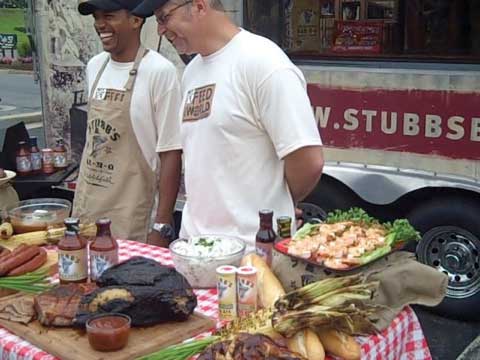
Source: Photo courtesy of Stubb’s Legendary Kitchen.
Press releases and other PR activities can also be used for damage control purposes. Damage controlCrisis management PR effort aimed to minimize any negative effects a company gets from bad publicity. is the process of countering the extreme negative effects a company gets when it receives bad publicity. Domino’s Pizza was forced to engage in damage control after two of its employees created a video doing disgusting things to pizzas and then posting it to YouTube. If the publicity is particularly bad, as it was for Domino’s, a company might hold a press conference or prepare a speech for the top executive to give. For example, the president of Domino’s spoke on video to try to control the damage to Domino’s business. The company then posted the video on YouTube (see the video below).
Video Clip
An Example of Damage Control
(click to see video)Patrick Doyle, the president of Domino’s, responds on YouTube to a video created by two Domino’s employees, who were subsequently fired by the pizza chain.
Similarly, companies that move into foreign markets are sometimes perceived negatively by locals because they have little information about the firms. In India, the reputation of companies is very important to workers and their families. As a result, U.S. employers recruiting in the tech industry in India often have to work hard to make their brands and products known so people will want to work for them. The firms do so via various PR efforts.
Just as press releases can be used to promote the good things an organization or person does, press conferences can also be held when a company is simply seeking good PR. An organization might hold a press conference to announce that it has hired new, highly sought-after executives, that it is breaking ground on a new building, or to talk about its community service projects.
Sponsorships
Many of you have heard of the Staples Center (Figure 12.2), where the Los Angeles Lakers play basketball. But imagine how many more people heard about the Staples Center following the announcement that Michael Jackson’s public memorial would take place there. All the news stories talking about tickets and information about the memorial provided “free” publicity for the center and for the office supplies store, Staples, for which the center is named. Staples paid $375 million for naming rights of the center, which was built in 1998.http://en.wikipedia.org/wiki/Staples_Center (accessed December 9, 2009). Indeed, the chain has gotten a huge return on its sponsorship of the center.
Figure 12.2
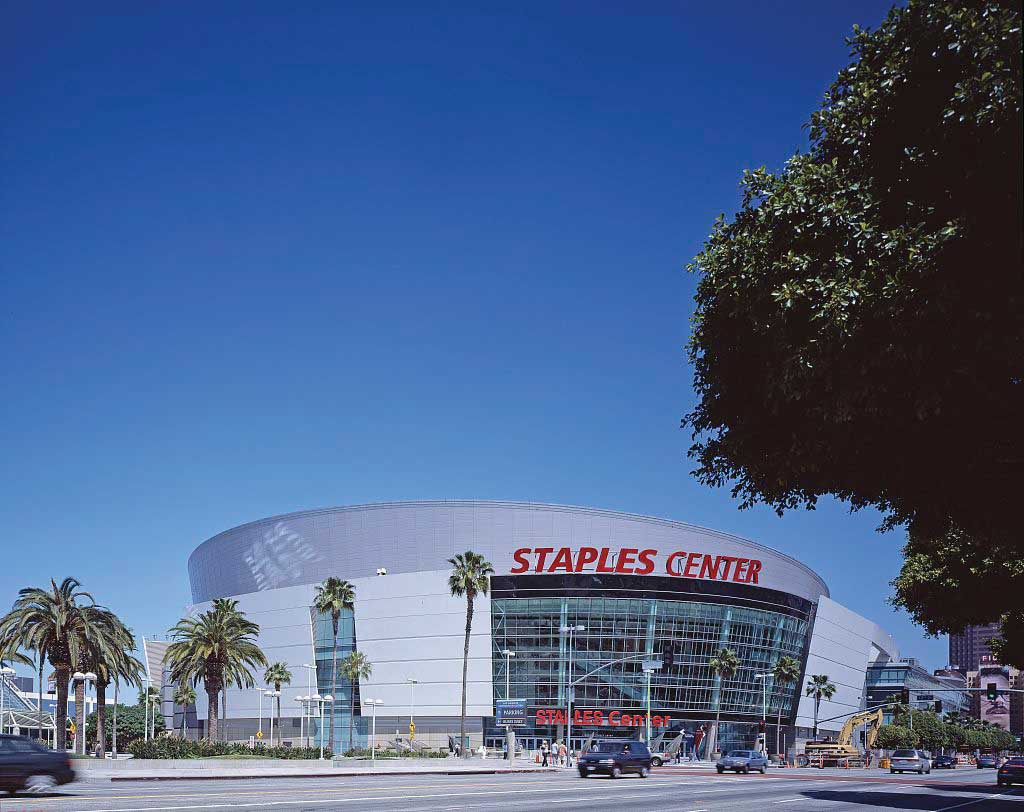
The Staples Center in Los Angeles is an example of a venue sponsorship. The office supplies store Staples paid for the naming rights to the stadium.
Source: Wikipedia.
A sponsorshipPaying a fee to have your name associated with different things such a particular venue, person’s apparel, or event, or even a NASCAR vehicle. involves paying a fee to have your name associated with different things, such as the following:
- A particular venue (Wrigley Field; the Staples Center)
- A superstar’s apparel (Tiger Woods wearing Nike hats and shirts)
- An event (the AT&T National Golf Tournament; the Chick-fil-A Peach Bowl)
- A cause (M&M’s support of the Special Olympics)
- An educational workshop or information session
- A NASCAR vehicle (by Pfizer, the maker of Viagra; see Figure 12.3)
Even though sponsorships are expensive, they are growing in popularity as corporations seek ways to strengthen their corporate image, increase their brand awareness, differentiate their products, and reach their target markets. Worldwide, corporations spent over $43 billion on sponsorships in 2008;“Events and Sponsorship 2008 Marketing Fact Book,” Marketing News, July 15, 2008, 26. however, the recession has taken a toll and the new stadium for the Dallas Cowboys still doesn’t have a sponsor with naming rights. Over two-thirds of the sponsorships in North America are for sports, followed by entertainment (e.g., music and performing arts) and causes (e.g., the Susan G. Komen Race for the Cure and “alternative spring breaks” for college students). Other organizations and structures, such as buildings and bridges, may seek sponsorships as a means of generating revenue. Imagine how many people drive across the Brooklyn Bridge in New York or the Golden Gate Bridge in San Francisco and how much awareness an organization would get if they were allowed to pay to have their name on either of the bridges.
Figure 12.3
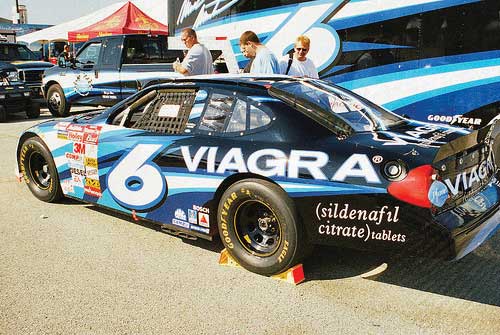
Pfizer, the maker of Viagra, is one of the many companies that sponsor NASCAR racing teams.
Source: Flickr.
Cause-related marketingWhen a company supports a nonprofit organization in some way in order to generate positive public relations. is one of the fastest-growing types of sponsorships. It occurs when a company supports a nonprofit organization in some way. For example, M&M’s sponsors the Special Olympics and American Airlines raises money for breast cancer research with an annual celebrity golf and tennis tournament. The airline also donates frequent flier miles to the cause. Yoplait Yogurt donates money for breast cancer research for every pink lid that is submitted. Cause-related marketing can have a positive PR impact by strengthening the affinity people have for a company that does it.
Video Clip
An Example of Sponsoring a Cause
(click to see video)M&M’s sponsors the Special Olympics.
Product Placements
Getting a company’s product included as part of a television show, movie, video game, special event, or book is called a product placementGetting a company’s product included as part of a television show, movie, video game, special event.. When you watch reruns of Seinfeld, you often see different Coca-Cola products being consumed. Likewise, you might see a Nissan Maxima on Desperate Housewives. Over four hundred product placements typically appear in each episode of The Biggest Loser. Apple placed products in twenty-four movies that reached number one between August 1, 2008, and August 1, 2009, while Ford products appeared twenty times and Budweiser products appeared twelve times.http://brandchannel.com/features_effect.asp?pf_id=489 (accessed December 9, 2009).
Video Clip
Example of Product Placement
(click to see video)Although the video sounds like a paid commercial, it is actually part of an episode of 30 Rock.
Typically, a company pays a fee to have one of its products placed. But sometimes the company pays nothing if the product is needed for a show in some way or as part of the plot. FedEx did not pay for product placement in the movie Castaway.http://en.wikipedia.org/wiki/Cast_Away (accessed December 9, 2009). Product placement can improve a brand’s awareness and exposure and often increase its sales. Given the number of exposures an organization receives with product placement, the cost of a product placement can be less expensive than commercials might cost.
Although most product placements appear in television shows and movies, corporations are pursuing other options. For example, they are now placing products in online videos, computer games, and books. The number of product placements is expected to increase as consumers continue to skip commercials and advertisements using digital video recorders (DVRs).
Key Takeaway
Public relations (PR) are the activities organizations engage in to create a positive image for a company, product, service, or a person. Press releases, sponsorships, and product placements are three commonly used PR tools. Press releases are designed to generate publicity, but there is no guarantee the media will use them in the stories they write. Sponsorships are designed to increase brand awareness, improve corporate image, and reach target markets. Product placements are designed to generate exposure, brand awareness, and interest.
Review Questions
- Why are public relations efforts funded by firms?
- Who does the public relations for a firm?
- Identify three public relation tools.
12.2 Sales Promotions
Learning Objectives
- Learn about different types of sales promotions companies use to get customers to buy their products.
- Understand the different types of sales promotions companies use with their business customers.
- Understand why sales promotions have become such an integral part of an organization’s promotion mix.
- Differentiate between a push and pull strategy.
Sales promotions are activities that supplement a company’s advertising, public relations, and personal selling efforts. Sales promotions are often temporary, but when the economy is weak sales promotions such as coupons become even more popular for consumers and are used more frequently by organizations. The goal of sales promotions is to persuade customers to take action quickly and make larger purchases. As discussed in Chapter 11 "Advertising, Integrated Marketing Communications, and the Changing Media Landscape", sales promotions in business-to-business (B2B) settings are typically called trade promotionsSales promotions aimed at businesses.; they are referred to as such because businesses “trade” or do business with other businesses.
Also as discussed in Chapter 11 "Advertising, Integrated Marketing Communications, and the Changing Media Landscape", companies use a pull strategyA strategy in which consumers are targeted with sales promotions such as coupons, contests, games, rebates, mail-in offers. when they target consumers with promotions. In other words, a company promotes it products and services to the final consumer to pull a consumer to the stores or get the consumer asking for the product. If a company sends coupons to the consumer, hopefully the consumer will take the coupon (sales promotion) to the store and buy the product. A push strategyA strategy in which businesses are the target of promotions so products get “pushed” through their marketing channels and sold to consumers. is used when businesses are the target of sales promotions so that products may be pushed through the channel to final consumers. For example, a manufacturer may provide incentives such as price discounts to the retailer who then promotes or pushes the product to the final consumer. Figure 12.4 "A Push versus a Pull Strategy" shows how push strategy differs from a pull strategy. Many organizations use both a pull and push strategy, promoting their products and services to both final consumers and their trade partners (retailers, wholesalers).
Figure 12.4 A Push versus a Pull Strategy
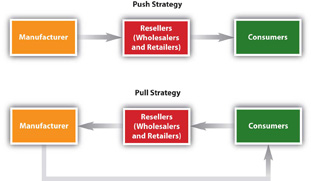
Types of Consumer Sales Promotions
Do you like free samples? Most people do. A sampleA small amount of a product given to consumers to try for free. is a sales promotion in which a small amount of a product that is for sale is given to consumers to try. Samples increase awareness, so the strategy encourages trial and builds awareness. You have probably purchased a product that included a small free sample with it—for example, a small amount of conditioner packaged with your shampoo. Have you ever gone to a store that provided free samples of different food items? The idea for giving away samples is to get people to buy a product. Although sampling is an expensive strategy, it is usually very effective for food products. People try the product, the person providing the sample tells consumers about the product, and mentions any special prices for the product.
In many retail grocery stores, coupons are also given to consumers with the samples. CouponsProvide an immediate price reduction off an item and the amount of the coupon is reimbursed to the retailer by the manufacturer. provide an immediate price reduction off an item. The amount of the coupon is later reimbursed to the retailer by the manufacturer. The retailer also gets a handling fee for accepting coupons. When the economy is weak, more consumers cut out coupons and look for special bargains such as double coupons and buy-one-get-one-free (BOGO) coupons. While many consumers cut coupons from the inserts in Sunday newspapers, other consumers find coupons for products and stores online. Stores may also provide coupons for customers with a loyalty card.
Consumers can also download coupons on many mobile phones. Mobile marketing and the Internet provide consumers in international markets access to coupons and other promotions. In India, the majority of coupons used are digital, while paper coupons have the largest share in the United States. Over 80 percent of diapers are purchased with coupons; imagine how much easier and less wasteful digital coupons scanned from a mobile phone are for both organizations and consumers.
Point-of-purchase displaysIn-store displays designed to encourage consumers to buy products immediately., including coupon machines placed in stores, encourage consumers to buy a product immediately. When a consumer sees a special display or can get a coupon instantly, manufacturers hope the sales promotion increases sales. Other sales promotions are conducted online. Online sales promotions include incentives such as free items, free shipping, coupons, and sweepstakes. For example, many online merchants such as Shoe Station and Zappos offer free shipping and free return shipping to encourage consumers to shop online. Some firms have found that the response they get to their online sales promotions is better than response they get to traditional sales promotions.
Another very popular sales promotion for consumers is a premium. A premiumSomething consumers get for free or a small handling charge with proof of purchase. is something you get either for free or for a small shipping and handling charge with your proof of purchase (sales receipt or part of package). Remember wanting your favorite cereal because there was a toy in the box? The toy is an example of a premium. Sometimes you might have to mail in a certain number of proofs of purchase to get a premium. The purpose of a premium is to motivate you to a buy product multiple times. What many people don’t realize is that when they pay the shipping and handling charges, they may also be paying for the premium.
Contests or sweepstakes also attract a lot of people. ContestsSales promotions that people enter or participate in order to win a prize. are sales promotions people enter or participate in to have a chance to win a prize. The Publisher’s Clearing House Sweepstakes and the Monopoly Game at McDonald’s are both examples. The organization that conducts the sweepstakes or contest hopes you will not only enter its contest but buy some magazines (or more food) when you do.
Video Clip
Want to Subscribe?
(click to see video)The Fantanas are back! Watch the video for a contest being conducted by Fanta soft drinks. As with other sales promotion tools, the idea is to get you to buy a product and more specifically to make repeat purchases.
Loyalty programsMarketing efforts that reward the frequent purchase and consumption of an offering. are sales promotions designed to get repeat business. Loyalty programs include things such as frequent flier programs, hotel programs, and shopping cards for grocery stores, drugstores, and restaurants. Sometimes point systems are used in conjunction with loyalty programs. After you accumulate so many miles or points, an organization might provide you with a special incentive such as a free flight, free hotel room, or free sandwich. Many loyalty programs, especially hotel and airline programs, have partners to give consumers more ways to accumulate and use miles and points.
RebatesA promotion whereby part of the purchase price of an offering is refunded to a customer after the customer completes a form and sends in the proof of purchase (sales receipt). are popular with both consumers and the manufacturers that provide them. When you get a rebate, you are refunded part (or all) of the purchase price of a product back after completing a form and sending it to the manufacturer with your proof of purchase. The trick is completing the paperwork on time. Many consumers forget or wait too long to do so. Consequently, they do not get any money back. This is why rebates are also popular with manufacturers. Rebates sound great to consumers until they forget to send it back.
Types of Trade Promotions
One of the most common types of sales promotions in B2B markets are trade shows. A trade showAn event in which firms in a particular industry display and demonstrate their offerings to other organizations they hope will buy them. is an event in which firms in a particular industry display and demonstrate their offerings to other organizations they hope will buy them. There are typically many different trade shows in which one organization can participate. Using displays, brochures, and other materials, representatives at trade shows can identify potential customers (prospects), inform customers about new and existing products, and show them products and materials. Representatives can also get feedback from prospects about their company’s products and materials, and perhaps about competitors.
Companies also gather competitive information at trade shows because they can see the products other firms are exhibiting and how they are selling them. While approximately 75 percent of representatives attending trade shows actually buy the product(s) they see, 93 percent of attendees are influenced by what they see at the trade shows. However, only 20 percent of organizations follow up on leads obtained at trade shows and only 17 percent of buyers are called upon after they express interest in a particular company’s products.John F. Tanner, Jr., and Dennis Pitta, “Identifying and Creating Customer Value” (special session presentation, Summer Educators’ Conference, Chicago, 2009). Figure 12.5 "A Samsung Display at the Consumer Electronics (CES) Trade Show in Las Vegas, Nevada, in 2009" is an example of a booth display at a trade show showcasing the Korean electronics firm, Samsung.
Figure 12.5 A Samsung Display at the Consumer Electronics (CES) Trade Show in Las Vegas, Nevada, in 2009
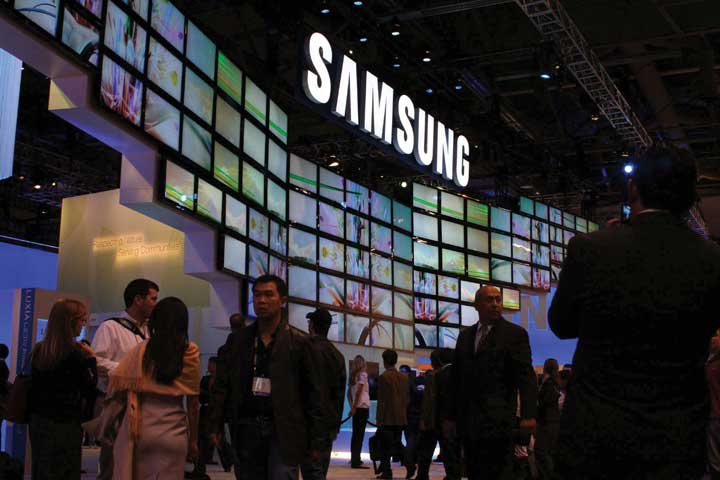
Source: Wikipedia.
ConventionsMeetings of groups of professionals that provide a way for sellers to showing potential customers different products., or meetings, with groups of professionals also provide a way for sellers to show potential customers different products. For example, a medical convention might be a good opportunity to display a new type of medical device. Sales representatives and managers often attend conventions to market their products.
Figure 12.6
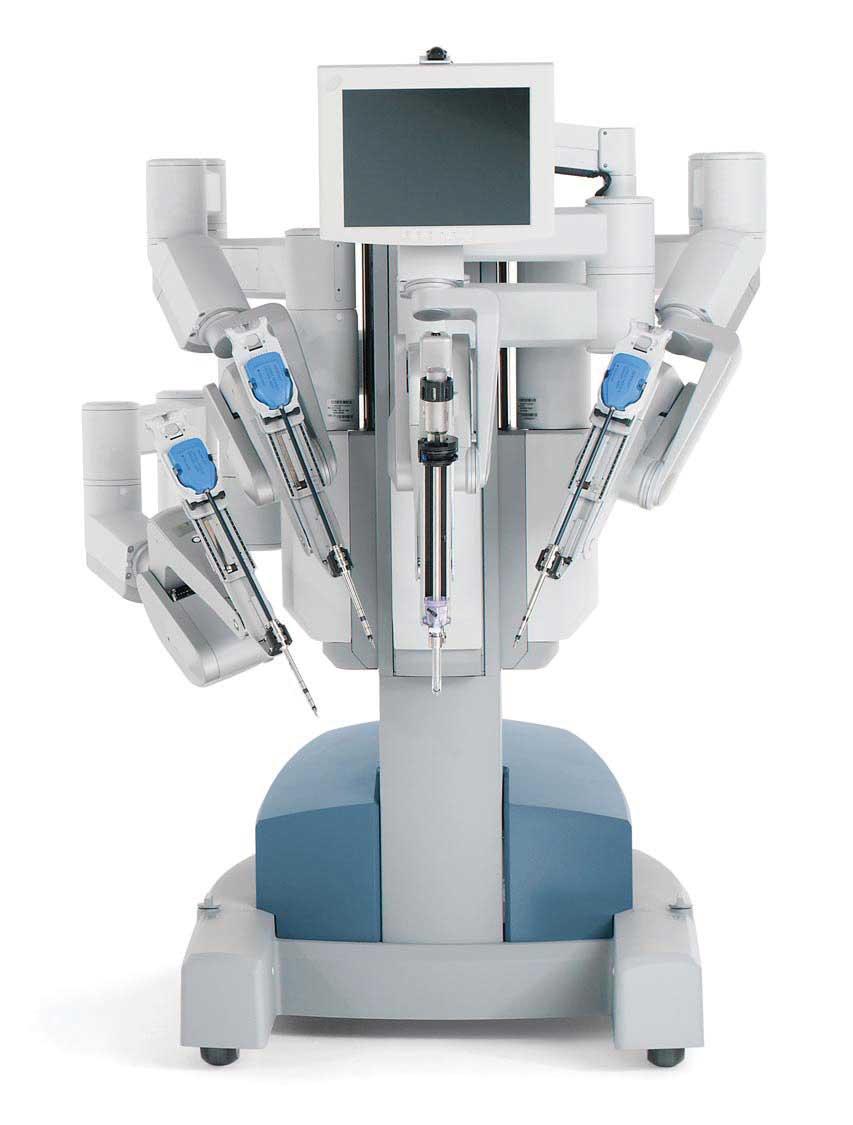
Intuitive Surgical is the maker of the da Vinci robot, a new type of technology used to make surgeries easy to perform and less invasive. Intuitive Surgical often demonstrates the robot at surgical conventions.
© 2010 Intuitive Surgical, Inc.
Sales contestsContests designed to motivate salespeople to increase their sales of particular products., which are often held by manufacturers or vendors, provide incentives for salespeople to increase their sales. Often, the contests focus on selling higher-profit or slow-moving products. The sales representative with the most sales of the product wins a prize such as a free vacation, company recognition, or cash.
Trade allowancesDiscounts an organization gives its channel partners for performing different functions. give channel partners—for example, a manufacturer’s wholesalers, distributors, retailers, and so forth—different incentives to push a product. One type of trade allowance is an advertising allowanceAn allowance (money) a manufacturer provide retailers to advertise its products in local newspapers. (money) to advertise a seller’s products in local newspapers. An advertising allowance benefits both the manufacturer and the retailer. Typically, the retailer can get a lower rate than manufacturers on advertising in local outlets, saving the manufacturer money. The retailer benefits by getting an allowance from the manufacturer.
Another sales promotion tool manufacturers offer businesses is trainingAssistance an organization offers its channel partner’s salespeople. The goal is to help them understand how the organization’s products work and how consumers can be enticed to buy them. to help their salespeople understand how the manufacturers’ products work and how consumers can be enticed to buy them. Many manufacturers also provide in-store product demonstrationsA demonstration designed to show a channel partner’s customers how products work and answer any questions they might have. to show a channel partner’s customers how products work and answer any questions they might have. Demonstrations of new video game systems and computers are extremely popular and successful in generating sales.
Free merchandiseA product or service a seller offers retailers in order to get them to push it toward consumers., such as a tool, television, or other product produced by the manufacturer, can also be used to get retailers to sell products to consumers. In other words, a manufacturer of televisions might offer the manager of a retail electronics store a television to push its products. If a certain number of televisions are sold, the manager gets the television.
Have you ever been to an electronics store or a furniture store and felt like the salesperson was pushing one particular television or one particular mattress? Perhaps the salesperson was getting push moneyA cash incentive a manufacturer provides its channel partners to sell particular items., or a cash incentive from the manufacturer to push a particular item. The push to the sell item might be because there is a large amount of inventory of it, it is being replaced by a new model, or the product is not selling well.
Figure 12.7 "Examples of Sales Promotions" recaps the different types of sales promotions designed for both consumers and businesses. Although different types of sales promotions work best for different organizations, rebates are very profitable for companies because, as you have learned, many consumers forget to send in their rebate forms. In a weak economy, consumers tend to use more coupons, but they also buy more store brands. Coupons available online or at the point of purchase are being used more often by consumers. Trade shows can be very successful, although the companies that participate in them need to follow-up on the leads generated at the shows.
Figure 12.7 Examples of Sales Promotions
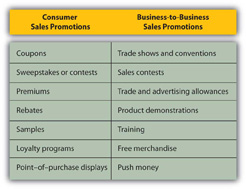
Key Takeaway
Companies use sales promotions to get customers to take action (make purchases) quickly. Sales promotions increase the awareness of products, help introduce new products, and often create interest in the organizations that run the promotions. Coupons, contests, samples, and premiums are among the types of sales promotions aimed at consumers. Trade promotions, or promotions aimed at businesses, include trade shows, sales contests, trade allowances, and push money.
Review Questions
- What are the objectives of sales promotions?
- What is a trade promotion?
- Identify and provide an example of three sales promotion tools targeted at consumers.
- Identify and provide an example of three sales promotion tools targeted at businesses.
- Explain the difference between a push strategy and pull strategy.
12.3 Discussion Questions and Activities
Discussion Questions
- Explain three different types of public relations tools that a company can use to generate interest in its products.
- As the manufacturer of small appliances, explain how you might plan to use both a push strategy and pull strategy.
- What type of sales promotions do you feel are most effective for college students?
Activities
- Create a sales promotion you think will attract a lot of students to your favorite fast-food restaurant.
- Write a press release about special activities your college or university is doing to help the environment or community.




